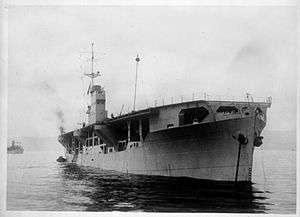MV Rapana
MV Rapana was one of nine Anglo Saxon Royal Dutch/Shell oil tankers converted to become a Merchant Aircraft Carrier (MAC ship). The group is collectively known as the Rapana class.
 MV Rapana. | |
| History | |
|---|---|
| Name: |
|
| Owner: | Anglo Saxon Royal Dutch/Shell |
| Operator: | Anglo Saxon Royal Dutch/Shell |
| Builder: | Wilton-Fijenoord, Schiedam, Netherlands |
| Launched: | March 1935 |
| Honours and awards: | Atlantic 1944-1945 |
| Fate: | Scrapped at Osaka in 1958 |
| General characteristics | |
| Displacement: | 8,017 GRT |
| Length: |
|
| Beam: | 59 ft (18 m) |
| Draught: | 27 ft 6 in (8.38 m) |
| Propulsion: |
|
| Speed: | 13 knots (24 km/h) |
| Complement: | 100 |
| Armament: |
|
| Aircraft carried: | Four Fairey Swordfish |
Rapana was launched in March 1935 at Wilton-Fijenoord, Schiedam, Netherlands as an oil tanker and completed in April 1935. She was converted to a MAC ship by Smiths Dock, North Shields, completing in July 1943.[1]
As a MAC ship, she had no aircraft hangar, and continued to carry normal cargoes, although operating under Royal Navy control. Only her air crew and the necessary maintenance staff were naval personnel.[2] Amongst the aircraft that served on Rapana was Fairey Swordfish Mk II LS326. The aircraft was later transferred to Empire MacCallum. As of November 2010, it is airworthy with the Royal Navy Historic Flight.[3]
After the war, MV Rapana was reconverted and returned to merchant service as an oil tanker and served in that role until scrapped in Osaka in 1958. She was renamed Rotula in 1950.
References
- "HMAS Rapana Aircraft Carrier Profile". Fleet Air Arm Archive. Retrieved 31 May 2011.
- H.T. Lenton & J. J. Colledge. Warships of World War II. Ian Allan. p. 296. ISBN 0-7110-0403-X.
- Howard, Lee (2010). "Return of the Stringbag". Aeroplane. No. December 2010. Kelsey Publishing. pp. 47–48, 53–55.